CHAPTER 2
UNSURFACED ROAD NETWORK IDENTIFICATION
2-1. General
are assigned a unique code to help store and
Before the unsurfaced road maintenance manage-
retrieve data from the files. This code has five
ment system can be used, the installation’s unsur-
characters that are numbers or letters given to the faced roads must be divided into components. This
branches using any logical order. The first letter of chapter defines the process.
the code will identify the type of branch, as shown in table 2-1. For example the parking lot 321
2-2. Components
shown in figure 2-2 is given the code P0321. The
code P0321 is derived from P representing parking
a. Unsurfaced road. An installation’s unsur-lots and 0321 representing the nearest building to faced road network consists of all unsurfaced areas the parking area. Since the building number has
that provide accessways for ground traffic, includ-less than four digits, a zero is used on the left to ing roadways, parking areas, storage areas, tank
provide the required characters.
trails, and range roads.
b. Brunch. A branch is an identifiable part of the unsurfaced road network that is a single entity Table 2-1. Branch codes
and has a distinct function. For example, individ-
Type of branch
First letter in
ual roads, parking areas, tank trails, and range
branch code
roads are separate branches of an unsurfaced road
Installation road
I
network.
P
c. Section. A section is a division of a branch; it Parking lot
has certain consistent characteristics throughout
Motor pool
M
its area or length. These characteristics are as
Storage
S
follows.
Tank trail
T
(1) Structural composition (thickness and ma-
Range road
K
terials).
(2) Construction history.
Other
X
(3) Traffic.
(4) Surface condition.
b. Dividing branches into sections.
d. Sample unit. A sample unit is an identifiable (1) Since branches are large units of the un-area of the unsurfaced road section; it is the
surfaced road network, they rarely have consistent smallest component of the unsurfaced road net-or uniform characteristics along their entire
work. Each unsurfaced section is divided into
length. Thus, for the purpose of unsurfaced road
sample units for the purpose of a condition inspec-management, each branch must be subdivided into
tion. For unsurfaced roads, a sample unit is de-
sections with consistent characteristics. As defined fined as an area of approximately 2,500 square
in paragraph 2-2c, a section must have uniform
feet (±1,000 square feet) (230 square meters [±90
structural composition, traffic, and the same con-
square meters]).
struction history.
(2) After each section is initially established,
2-3. Guidelines for unsurfaced road identifica-
surface condition, drainage, and shoulders within
tion
the section can be used to subdivide it into other a Dividing the unsurfaced road network into
sections if a considerable variation in condition is brunches. The first step is to identify the unsur-encountered. For example, a section containing
faced road branches. The easiest way to identify
part of a two-lane road that has one lane in a
these branches is to use the installation’s existing significantly different condition than the other
name identification system.
lane should be subdivided into two sections.
(1) For example, Boot Hill Road in figure 2-1
Unique situations such as those that occur at
would be identified as a branch. Areas such as
roadway intersections should also be placed in
parking lots and storage areas that do not have
separate sections. However, it must be remem-
names already assigned can be given descriptive
bered that the major section’s structure usually
names that associate them with their area.
carries through an intersection. The structure
(2) In addition to descriptive names, branches
should be checked if there is doubt as to which
2-1






TM 5-626
Figure 2-2. Installation map showing a way of identifying a
parking area branch.
recommended that shoulder type and drainage
facilities be consistent throughout a section.
(f) Test areas. An area where materials
have been placed for testing should be identified
as a separate section.
(3) By using the criteria in subparagraphs
(2) (a) through (f) above, the unsurfaced road branches can be divided into sections. Sections are numbered beginning with one at the north or west
Figure 2-1. Typical road sections
end of the branch. The numbers then increase in a
southerly or easterly direction. Each section
surface would continue through the intersection.
should be identified on the installation map.
Some guidelines for dividing unsurfaced network
(4) To identify a section on the installation
branches into sections are as follows.
map, place an arrow at the starting point and
(a) Structure. Structure is one of the most ending point of each section as shown in figure
important criteria for dividing a branch into sec-
2-3. Sample units should be numbered in ascend-
tions. Structural information is not always avail-
ing order from the beginning of each section.
able for all branches of an unsurfaced road net-
(5) Subparagraphs (2) (a) through (f) above that work. To collect structure information, available
apply to roadways may also be applied to branch
construction records can be searched and repairs
types, such as parking areas, storage areas, tank
can be observed. In addition, test pits or coring
trails, range roads, etc. These branch types are
programs can be developed to determine the struc-
usually considered one section, but may be subdi-
tural composition of remaining road sections or to vided. For example, a parking lot could be divided verify existing information.
into more than one section; if the parking lot’s
(b) Traffic. The volume and load intensity of drive areas were well defined, each drive area
traffic should be consistent within each individual should be identified as a separate section.
section.
(6) An example of dividing a parking area
(c) Construction history. All portions of a into sections is shown in figure 2-4. The area is
section should have been constructed at the same
very large and defined as one branch with five
time. Roads constructed in intervals should be
sections. The basic division of sections is based on divided into separate sections corresponding to the traffic patterns and use. Field observations of
dates of construction. Areas that have received
these types of branches will help in the decision of major M&R work should also be considered as
how to divide such an area into sections.
separate sections.
c. Dividing a section into sample units. A sample (d) Unsurfaced road rank. Unsurfaced road unit is the smallest component of the unsurfaced
rank can also be used to divide a branch into
road network and is used for inspection purposes
sections. If a branch changes along its length from to determine existing surface distress and condi-second class to third class, a section division
tion. This is where the actual measurements will
should be made. If a branch becomes narrower
be made.
along its length, a separate section should be
(1) The sizes of the sample units are described
defined.
in paragraph 2-2 d. For unsurfaced roads, a sample (e) Drainage facilities and shoulders. It is unit may vary in size from approximately 1,500 to
2-2










TM 5-626
Figure 2-3. Sections identified on an installation map 3,500 square feet (140 to 325 square meters), with a recommended average of 2,500 square feet (231
square meters). In general, sample units are 100
feet (30 meters) long. If the road is narrower than 15 feet (4.5 meters), the length should be increased. If the road is wider than 35 feet (10.5
meters), the length should be shortened (see figure 2-5).
(2) Some judgment is needed in selecting the
sample units. Try to choose a sample unit that is
typical of the whole section. For example, if the
section has drainage problems along part of its
length, try to include some of that in the sample
unit. The idea is to choose sample units so that the measurements will give a fair estimate for the
entire section.
(3) If a small part of the section has particu-
larly severe problems, make that part a special
sample unit. (Make sure to note this on the
inspection sheet, and don’t use the rating for this unit when you calculate the average for the
section.)
(4) In general, only two sample units per mile
(per kilometer) are needed. If the road is less than 1/2 mile (0.8 kilometer) long, one sample unit
should be sufficient.
(5) It is important to make a map showing the
sizes and locations of the sample units so that you can find them again. Also, mark the field sites
with permanent markers, i.e., wood stake, pipe,
re-bar, etc.
Figure 2-4. Large parking area divided into several sections.
2-3
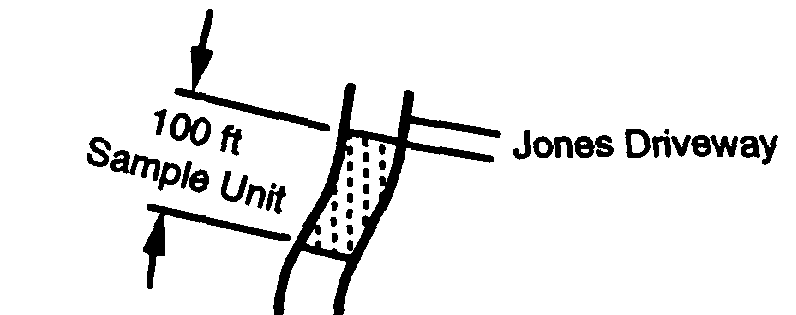
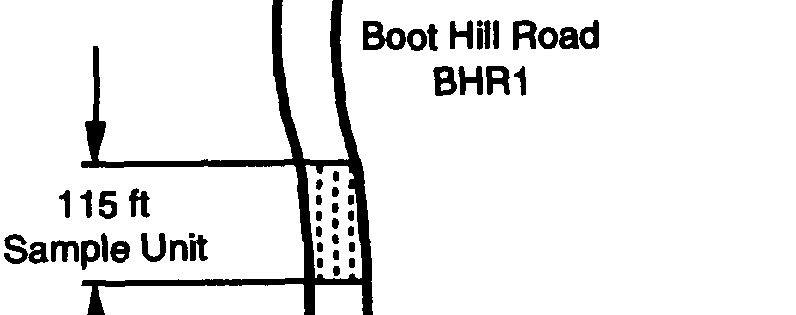
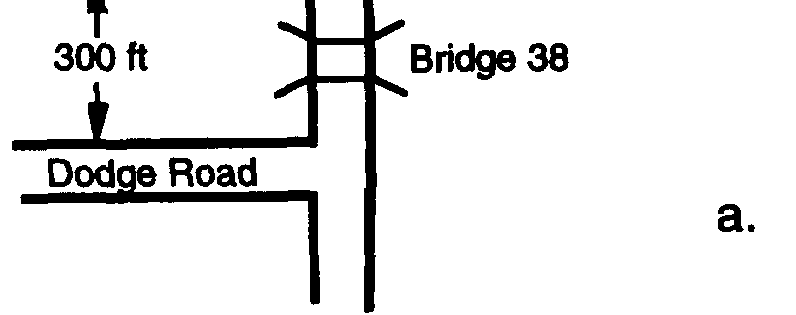


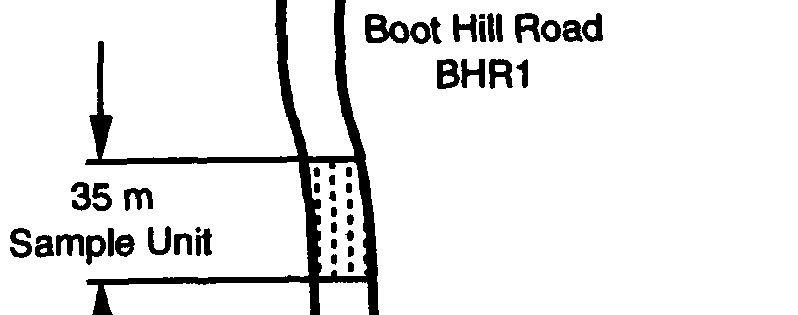
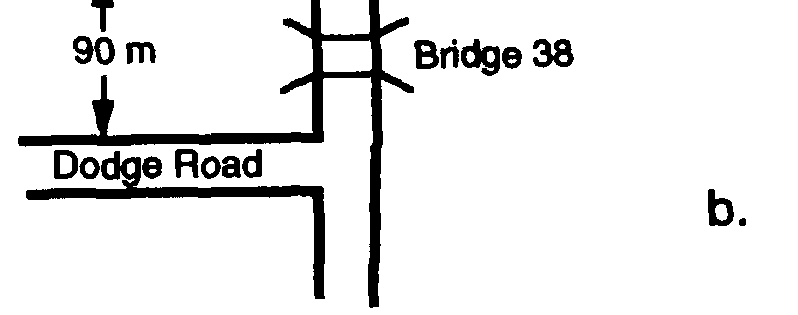

TM 5-626
Figure 2-5. Examples of road with sample units (English and metric units).
2-4
TM 5-626



























